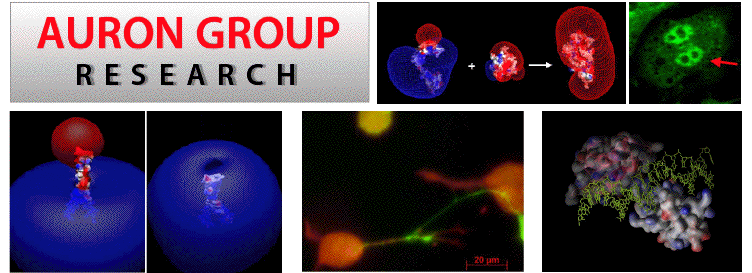The Auron Research Group
The research focuses on molecular mechanisms of cytokine gene regulation. One of these cytokines is interleukin 1 (IL-1) which influences genes expressing various proteins that can modulate the level of acute and chronic inflammation and thus mediate subsequent fever and tissue destruction. In 1984, Dr. Auron was involved in the original cloning and characterization of IL-1beta cDNA. This was followed by the isolation and sequencing of the corresponding IL1B gene locus. The induced IL1B gene product is involved in inflammatory diseases such as rheumatoid arthritis, inflammatory bowel disease, arteriosclerosis, bacterial sepsis and infection by certain viruses.
The laboratory has placed emphasis on the detailed molecular processes and structures involved both in receptor signal transduction and gene transcription in normal cells and those expressing proinflammatory proteins derived from cytomegalovirus infection. Attention has also been paid to cell-type-specific expression. As a result, Dr. Auron and his collaborators have determined that the monomyeloid-specific ETS domain transcription factor, Spi-1/PU.1, is required for vigorous expression of the IL1B gene. They have also determined that physical interaction between Spi-1 and GATA-family proteins is responsible for a mutual inhibition that is critical for stem cell commitment to erythroid vs. mono-myeloid lineage development in hematopoiesis. Spi-1, which is essential for monocyte and osteoclast development, binds to the IL1B gene and couples the gene induction signal, found in a distinct location approximately 3kbp upstream from the transcription start site, directly to the general transcription machinery. The Spi-1/PU.1 factor is also targeted during human cytomegalovirus (HCMV) infection and mediates viral-induction of IL1B by eliminating the requirement for the exogenous activation signal via one specific HCMV protein (IE2, immediate early protein 2). Research focusing on receptor signal transduction has resulted in the discovery that the IL-1 receptor-activated intracellular signal transducer called TRAF6 functions through at least two distinct pathways that result in differential activation of Rel/NF-kB transcription factor family members. This may be responsible for some of the known subtleties of the inflammatory response.
Methods being employed by the laboratory include:
1) Identifying protein domains capable of supporting various protein-protein interactions;
2) examining these domains by computer molecular modeling in order to design dominant-negative mutations and small molecule inhibitors;
3) determining whether the inhibitors can function in vivo and serve as potential therapeutics; and
4) single-cell techniques involving microscopic examination of protein domains fused to full-length and split-GFP (BiFC, bimolecular fluorescence complementation) probes in living cells. Studies are aimed at examining sub-cellular localization and protein-protein interaction for wild-type and modified proteins such as transcription factors, signaling molecules, and kinases involved in IL-1 receptor signal transduction.
IL1B GENE REGULATION
The gene coding for human interleukin 1 beta (IL1B) is expressed most vigorously in monocytes activated via Toll-like receptors, such as TLR4 which responds to lipopolysaccharide (LPS). This signal transduction event, which is mediated by the cytoplasmic mediator TRAF6, activates latent transcription factors which target specific regions of the IL1B gene, resulting in immediate-early transcription. Ongoing research is aimed at identifying relevant factors and genomic functional structure using in vivo approaches such as chromatin immunoprecipitation (ChIP) and chromatin conformational capture (3C) on cell lines and primary cells. One goal is to understand the relative importance of distinct factors and design specific inhibitors that could function as novel anti-inflammatory drugs.
Protein Tethered Transactivation
We have been very interested in the process by which DNA-binding transcription factors can induce gene expression in the absence of direct DNA binding. We have referred to this process as protein tethered transactivation (PTT). In PTT one transcription factor can bind a DNA target site and in-turn recruit a second DNA-binding factor in the absence of a cognate site via a protein-protein interaction. The recruited factor can then increase the level of transcription by serving as a cofactor, much like CEBP/p300 which cannot directly bind DNA. We have demonstrated at least two such occurrences of this phenomenon on the IL1B gene (involving DNA-bound Spi-1 interacting with either HCMV IE2 or with C/EBPbeta) and one on the gene coding for IL-8 (involving DNA-bound NF-kB p65 interacting with non-tyrosine phosphorylated Stat3). We have discovered other such interactions, and would like to determine how common PTT is throughout the genome.
Mechanism of TRAF6 Signal Transduction
TRAF6 is a downstream signaling molecule used in common by the entire family of Toll-IL1/IL18 receptors (TIRs). Effort is focused on examining the sub-cellular localization and protein interaction partners of TRAF6 by the use of fluorescent probes that are activated only in the presence of a cognate interaction partner. These probes use the principle of bimolecular fluorescence complementation (BiFC) in which two inactive fluorescent protein fragments (split-GFP) are activated upon association mediated by tethered interacting proteins. This approach permits the observation of protein-protein interaction in living cells following receptor-mediated activation. We have also used full-length GFP probes fused to various plextrin homology (PH) domains (e.g., that of Akt and Tec kinases) to monitor the generation of phosphoinositides within cell membranes following over-expression of various activating molecules, including wild-type and mutated TRAF molecules.
Cytomegalovirus Induction of IL1B
Human cytomegalovirus (HCMV) is a pro-inflammatory virus that induces the IL1B gene. Studies are aimed at understanding the distinct roles played by two different HCMV-derived proinflammatory stimuli. Exogenous stimuli (such as envelope glycoprotein B activation via TLR2) and endogenous stimuli (such as IE2 activation of host Spi-1/PU.1) are being examined in order to determine the relative importance of each pathway.
 |
